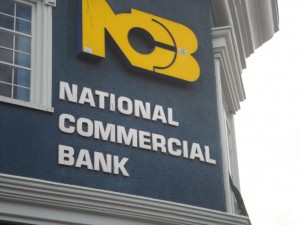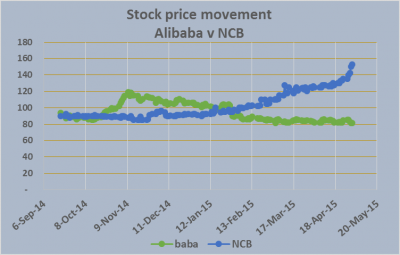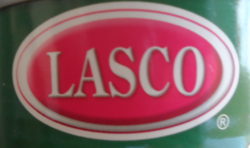 The slippage of the Jamaican dollar was halted on Monday against the US and the Canadian dollar but it rose against the British currencies as purchases of all currencies by dealers amounted to US$45,348,873 equivalent, compared with US$34,733,786, on Friday and selling of the equivalent of US$39,052,916 versus sale of US$32,565,352, previously.
The slippage of the Jamaican dollar was halted on Monday against the US and the Canadian dollar but it rose against the British currencies as purchases of all currencies by dealers amounted to US$45,348,873 equivalent, compared with US$34,733,786, on Friday and selling of the equivalent of US$39,052,916 versus sale of US$32,565,352, previously.
In US dollar trading, dealers bought US$40,589,132 compared to US$32,036,309 on Friday. The buying rate for the US dollar fell 3 cents to $115.18 and US$36,727,675 was sold versus US$30,771,394 on Friday, the selling rate was unchanged at $115.74. The Canadian dollar buying rate jumped $1.37 to $94.19 with dealers buying C$2,570,440 and selling C$1,724,288, at an average rate that remained at $95.43.  The rate for buying the British Pound fell 51 cents to $172.98 for the purchase of £1,664,090, while £397,770, was sold, at an average rate that declined by $1.52 to $174.71. At the end of trading it took J$129.89 to purchase the Euro, 29 cents more than on Friday, according to data from Bank of Jamaica, while dealers purchased the European common currency at J$127.36 for a rise of 36 cents on Friday’s rate. Other currencies bought, amounted to the equivalent of US$158,563, while the equivalent of US$303,185, was sold.
The rate for buying the British Pound fell 51 cents to $172.98 for the purchase of £1,664,090, while £397,770, was sold, at an average rate that declined by $1.52 to $174.71. At the end of trading it took J$129.89 to purchase the Euro, 29 cents more than on Friday, according to data from Bank of Jamaica, while dealers purchased the European common currency at J$127.36 for a rise of 36 cents on Friday’s rate. Other currencies bought, amounted to the equivalent of US$158,563, while the equivalent of US$303,185, was sold.
Highs & Lows| The highest buying rate for the US dollar, rose 15 cents to $116.30. The lowest buying and highest selling rates remained at $94.36 and $120.91 respectively, with the lowest selling rate falling $2.28 to $93.94. The highest buying rate for the Canadian dollar climbed $1.40 to $97.  The lowest buying rate declined by 17 cents to $75.36, the highest selling rate rose 13 cents to $97.50 and the lowest selling rate fell 20 cents to $90.80. The highest buying rate for the British Pound, declined $1 to $176, the lowest buying rate dipped 33 cents to $140.77, the highest selling rate rose $1.18 to $181.47 with the lowest selling rate falling 40 cents to $169.60.
The lowest buying rate declined by 17 cents to $75.36, the highest selling rate rose 13 cents to $97.50 and the lowest selling rate fell 20 cents to $90.80. The highest buying rate for the British Pound, declined $1 to $176, the lowest buying rate dipped 33 cents to $140.77, the highest selling rate rose $1.18 to $181.47 with the lowest selling rate falling 40 cents to $169.60.
J$ steady against US & Canadian
Market makes small correction
Although there were more stocks rising than falling, declines in the prices of National Commercial Bank and Scotia Group were the main reason behind the fall. At the close, the JSE Market Index lost 606.45 points to 95,482.64,
 the JSE All Jamaican Composite index fell 678.03 points to close at 105,472.32 and the JSE combined index dropped 514.59 points to close at 97,418.36.
the JSE All Jamaican Composite index fell 678.03 points to close at 105,472.32 and the JSE combined index dropped 514.59 points to close at 97,418.36.IC bid-offer Indicator| At the end of trading, in the main and junior markets, the Investor’s Choice bid-offer indicator shows 11 stocks with bids higher than their last selling prices and only 2 with offers that were lower.
In trading, Cable & Wireless ended with 899,126 shares trading at 48 cents, Caribbean Cement closed with 3,506,670 units trading 20 cents higher to $4.20, but the stock traded as high as $5. Trading was halted in the stock when it initially hit $5, that price, exceeded 15 percent permitted initially, but on resumption after an hour and minutes before trading closed, the trade at the high, went through. Carreras finished with 8,160 units as the price slipped 32 cents to $47.18, Grace Kennedy finished trading with 216,915 units and put on 41 cents to close at $64.01. JMMB Group concluded trading with just 10,465 shares and closed with a gain of 30 cents at a new 52 weeks’ high of $8.30,
 Mayberry Investments traded 264,418 units to close higher by 14 cents higher at $2.79 for a new 52 weeks’ high. National Commercial Bank finished trading with 3,569,062 shares but the price dropped by 51 cents to $29.99 after trading as high as $30.50, Sagicor Group had dealings in 34,220 units to close with a gain of 47 cents, to a new 52 weeks’ closing high of $12. Scotia Group contributed 1,236,023 units with a decline of 49 cents to $25, Scotia Investments ended with 19,550 shares trading lower by $2.72 to $24.28, Supreme Ventures closed with 31,377 shares trading with a gain of 1 cent to a new 52 weeks’ closing high of $3.51 and Proven Investments finished with 22865 units to end at 21 US cents.
Mayberry Investments traded 264,418 units to close higher by 14 cents higher at $2.79 for a new 52 weeks’ high. National Commercial Bank finished trading with 3,569,062 shares but the price dropped by 51 cents to $29.99 after trading as high as $30.50, Sagicor Group had dealings in 34,220 units to close with a gain of 47 cents, to a new 52 weeks’ closing high of $12. Scotia Group contributed 1,236,023 units with a decline of 49 cents to $25, Scotia Investments ended with 19,550 shares trading lower by $2.72 to $24.28, Supreme Ventures closed with 31,377 shares trading with a gain of 1 cent to a new 52 weeks’ closing high of $3.51 and Proven Investments finished with 22865 units to end at 21 US cents.
Light trading as 4 stocks rose
Trading on the Trinidad Stock Exchange was with 13 securities changing hands of which 4 advanced, 1 declined and 8 traded firm with a total of 510,508 units, valued at $2,696,066.
 At the close of the market, the Composite Index rose 0.72 points to close at 1,153.12, the All T&T Index gained 1.43 points to close at 1,968.24 and the Cross Listed Index remained at 44.32.
At the close of the market, the Composite Index rose 0.72 points to close at 1,153.12, the All T&T Index gained 1.43 points to close at 1,968.24 and the Cross Listed Index remained at 44.32.
Gains| Stocks increasing in price at the close are, First Citizens Bank trading only 277 shares, to close with a gain of 1 cent at $35.77. Guardian Holdings with 26,723 shares trading for $378,664, ended with a gain of 2 cents at $14.17, Massy Holdings trading 121 shares to close with a gain of 5 cents at $63.42 and Trinidad Cement with 395,056 shares changing hands for a value of $1,145,163, gained 15 cents to end the day at $2.90.
Declines| Clico Investment Fund is the sole stock declining at the end of trading with 29,500 shares valued at $665,031 but declined by 1 cent to end at $22.54.
Firm Trades| Stocks closing with prices unchanged are, Agostini’s trading 500 shares traded at $17.25, Ansa Merchant Bank contributed 3,871 shares to close unchanged at $38.90, Grace Kennedy trading 1,100 units to close at $3.49. JMMB Group trading 12,000 shares to end at 50 cents, One Caribbean Media with just 10 shares changing hands, closed at $22.30, Prestige Holdings added 17,300 shares valued at $173,006 to close at $10, Republic Bank with 50 shares, closed at $115 and Sagicor Financial Corporation contributed 24,000 shares with a value of $141,600 and closed at $5.90.
IC bid-offer Indicator| At the end of trading the Investor’s Choice bid-offer indicator had 4 stocks with the bid higher than their last selling prices and 1 with a lower offer.
Juniors gain with 5 stocks rising
An indicator of the state of the market at the close, can be seen by the number of stocks with bids versus offers, as well as the numbers that close with bids being higher or lower than the last sale price. AT the close there were 4 stocks with bids higher than their last selling prices and only 1 with a lower. The junior market ended with 5 securities closing with no bids to buy and 9 securities that had no stocks being offered for sale.
Stocks trading in the junior market are, Blue Power trading 6,000 units and gained $1.30 to end at $8.81.
 Caribbean Cream had 11,000 units changing hands and ending 16 cents higher at 81 cents, Caribbean Producers had 80,935 shares trading at $2.99 with a loss of 11 cents. Cargo Handlers closing at an all-time high of $21, while trading 10,000 units, to gain 89 cents. Honey Bun gained 2 cents, in trading 1,500 shares to end at $1.90, up 8 cents, Jamaican Teas had 12,422 units changing hands at $2.55, Knutsford Express closed with 7,016 units changing hands at $6, Lasco Distributors had 523,076 shares trading to close at $1.45 with no stock on offer at the close. Lasco Financial Services had 3,500 units changing hands traded at the close at $1.30, Lasco Manufacturing traded 821,444 shares and closed at $1.35 and Medical Disposables ended with 300,000 trading at $1.70.
Caribbean Cream had 11,000 units changing hands and ending 16 cents higher at 81 cents, Caribbean Producers had 80,935 shares trading at $2.99 with a loss of 11 cents. Cargo Handlers closing at an all-time high of $21, while trading 10,000 units, to gain 89 cents. Honey Bun gained 2 cents, in trading 1,500 shares to end at $1.90, up 8 cents, Jamaican Teas had 12,422 units changing hands at $2.55, Knutsford Express closed with 7,016 units changing hands at $6, Lasco Distributors had 523,076 shares trading to close at $1.45 with no stock on offer at the close. Lasco Financial Services had 3,500 units changing hands traded at the close at $1.30, Lasco Manufacturing traded 821,444 shares and closed at $1.35 and Medical Disposables ended with 300,000 trading at $1.70.
Ansa Mcal 2014 profit falls
 “The Group delivered top line revenues of $1,439 million compared to $1,305 million in 2012 an increase of 10 percent, but this translated to a 6 percent increase in pre-tax and after tax profit, over the prior year, thanks to lower interest cost. The real issue is that profit fell in the quarter before charging interest on loan funding, but for this, profit would have been down as the group reported operating profit of $211 million down from $222 million in 2011 first quarter” was, IC Insider in comments in early 2013 on Ansa Mcal first quarter results of that year.
“The Group delivered top line revenues of $1,439 million compared to $1,305 million in 2012 an increase of 10 percent, but this translated to a 6 percent increase in pre-tax and after tax profit, over the prior year, thanks to lower interest cost. The real issue is that profit fell in the quarter before charging interest on loan funding, but for this, profit would have been down as the group reported operating profit of $211 million down from $222 million in 2011 first quarter” was, IC Insider in comments in early 2013 on Ansa Mcal first quarter results of that year.
What has happened since? According to the group’s 2014 audited accounts, profits are down for 2014, having picked up slightly in 2013. Sales revenues amounted to $6.1 billion, down slightly from $6.2 billion in 2013, generating profit before tax of $1.07 billion down from $1.14 billion in 2013 and earnings per share of $3.97 versus $4.31. Profit after tax due to the group’s shareholders amounted to $685 million, a decline of 8 percent from $742 million in 2013. In 2012, the group reported profit of $634 million, in 2011, profit of $597 million that was down on the $621 million earned in 2010, reflecting a continuous trend of little or no growth, which has been typical of many of the Trinidadian companies in recent years. The group boast total assets in excess of $13 billion at the end of 2014.
“Strong gains in our automotive, trading and distribution segment offset the decline in manufacturing, packaging and brewing segment” was what Management advised shareholders of in their report to them.
Buy hold sell| The group is financially strong, with a well-diversified portfolio of businesses that can help it weather economic storms. With the price of oil having fallen, inflation and interest rates on the rise again in Trinidad & Tobago, the group’s main market, it is difficult to see a major resurgence in Ansa’s fortunes in the medium term.
The PE of the stock is around 17 times earnings, the dividend yield is a low 2 percent with a dividend of $1.30 per annum. The stock trades on the Trinidad & Tobago Stock Exchange and is best left alone until there are clear signs of profit uplift.
Carib Cement shares frozen
 Caribbean Cement is now listed as trading at $5 which would be the highest for more than a year, but the trade pushing the price to that level has, resulted in the stock being frozen from trading for an hour.
Caribbean Cement is now listed as trading at $5 which would be the highest for more than a year, but the trade pushing the price to that level has, resulted in the stock being frozen from trading for an hour.
The stock can trade up to another 15 percent higher from the $4.60 or a maximum of $5.29 for the day. Mayberry Investments crossed 300,000 units at $4.08 shares which were sold from in house inventory to a client similarly another 1,000,000 units at $4.18 and 2,000,000 units at $4.20 was similarly traded by them fro in house inventory.
Mayberry Investments also traded 177,448 shares at $4.80 and 7,000 at $5 both these trades exceeded the permitted price change of 15 percent which led to the stock be frozen unit 11.48am. the stock has been responding to a big jump in profit for the first quarter, suggesting earnings should exceed $1 per shares.
JSE off to tamer start than Friday
Trading on the Jamaica Stock Exchange stared off the week on a calmer note, than it did last Friday but there have been a few sizable trades so far. 
The larger trades in the first hour of trading are, Caribbean Cement with 300,000 changing hands at $4.08, Grace Kennedy 215,470 shares at $64, National Commercial Bank 3,512,412 shares at $30 and Scotia Group first traded 690,287 shares at $25 and then added more at $24.50 and a 1,390 units traded at $25, to bring the total to 714,543 units. The bulk of the National Commercial Bank shares were crosses done by NCB Capital Markets and that of Scotia Group were crosses done by Scotia Investments as well as purchased from other brokers. Thirteen stocks have traded so far amounting to 4.99 million units with four coming from the junior market.
Main Market| The JSE Market Index gained 712.88 points to 95,376.21, the JSE All Jamaican Composite index jumped 797.02 points to close at 105,353.33, just below the level reached on November 11, 2011 and the JSE combined index leaped 679.81 points to close at 97,253.14.





 When rates start reversing there is going to be some shake out. Rising interest rates and uncertainty drove down stocks value in Jamaica since 2013. Last year Interest rates started to fall and the local stock market started to respond by June last year, slowly at first, but it gradually gathered momentum and by October really started to move up and accumulating in a rise of 36 percent in the main market stocks since.
When rates start reversing there is going to be some shake out. Rising interest rates and uncertainty drove down stocks value in Jamaica since 2013. Last year Interest rates started to fall and the local stock market started to respond by June last year, slowly at first, but it gradually gathered momentum and by October really started to move up and accumulating in a rise of 36 percent in the main market stocks since. NCB returns less the effect of devaluation of the Jamaican dollar which still leaves a huge gain. On the other hand, Alibaba is now at US$81 and looks like it may well head lower while
NCB returns less the effect of devaluation of the Jamaican dollar which still leaves a huge gain. On the other hand, Alibaba is now at US$81 and looks like it may well head lower while 






I cannot understand
I remember the days when there were heavy trading in stocks in Jamaica, in the 1990s when the market trading data was manually compiled and the indices computed manually. Back then, it took quite a while for the final report to be issued because they had to make sure the information was correct. Now we have errors being reported daily and there is no information going out to public to correct the errors.
I don’t understand for example why Sterling Investment could have told shareholders in their circular reporting the allocation for rights, for them to subscribe to, that the number of shares in issue is 40 million units and that the record date for the stock split was March 8 this year, and that the notice was published on the JSE website, yet a check on the trading sheets show no change in the trading prices of the stock with the last trading price, the highs and lows still at $134 nor the amount of shares in issue.
The last time we checked, the Manager at the exchange explained that there was a computer programming problem that prevented the highs and lows from being corrected in the case of the three Lasco companies. But that was from 2013, surely they must be able to sort that out by now and certainly, they ought not to be sending false data to the public without some notation to indicate what is the correct. One has to question where is the FSC in all of this?
Recently a reader wrote of his concern about small trades which he asked his broker to avoid, here is what was said “the purchase of 200 Brow and 100 SVL: can you try to avoid such transactions by whatever means possible: deleting buy orders when only small volumes are available, deleting orders when only a small balance is remaining to be filled, etc- whatever you can do. This is retrograde step which JSE has taken and they are wrong in saying that is a global standard. I sure that it is not.”
The reader is absolutely correct. I had a case where a small amount of Cable & Wireless shares were traded, based of the various fees charged by the JSE and the brokers I ended up owing the broker although I sold the stock, that by the way is not a joke. I get the impression that the stock exchange sees investors the way the government sees tax payers, just milk them and ignore their pleas for we have the power. Whatever happened to customer friendliness or the customer is king or queen? Barbados has a system where small trades as routed through the odd lot market. Why can’t we do the same or better yet, treat orders as one trade for fee purposes when such orders are filled from many smaller amounts. Whatever the system the present one is wrong.